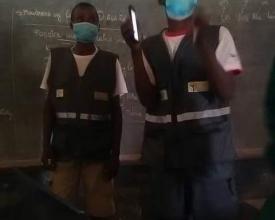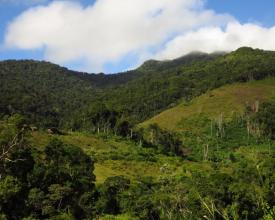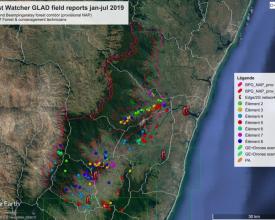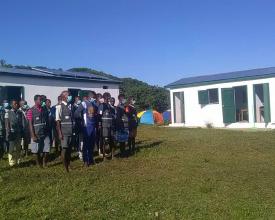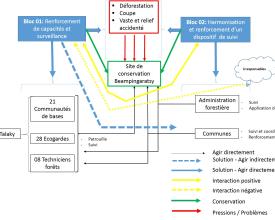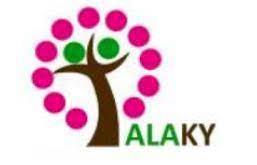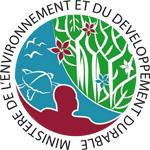
Biodiversity conservation through the implementation of an early warning pressure monitoring system
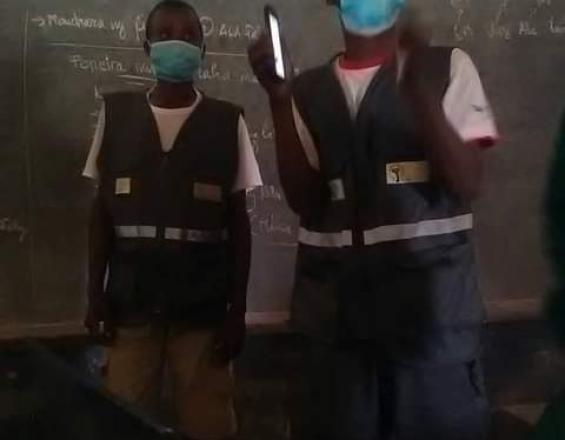
The historical average deforestation rate (2005-2015) in the Beampingaratsy forest reference area is 749 ha/year. The Malagasy government, under the aegis of the Ministry of the Environment, has a number of policies and measures in place, but they are not having a significant impact on reducing forest pressure. As of 2018, the results of the Talaky project show a net reduction in deforestation of around 236 ha/year. By 2020, 74.75% of pressure alerts issued by Forest watcher are recorded using the GeoODK form and are all verified. These positive and concrete results are thanks to the use of Forest Watcher and GeoODK in forest conservation.
Context
Challenges addressed
- The Forest watcher application detects pressure alerts and the GeoODK application is used to collect data in the field. This data is transferred to a server.
- The co-management forestry technicians use the forest watcher and inform the ecoguards and polisin'ala of the grassroots community of alerts detected by the forest watcher. Ecoguards collect data via the GeoODK application.
- Field descent: all alerts received by forest watcher must be verified in the field by polisin'ala and ecogarde, but this descent depends on the security situation in the descent zone.
- The descent with the forest administration is carried out as follows: the right-of-use zone is managed by the grassroots community via the approved "DINA" regulation. The conservation zone is managed in accordance with current forestry legislation.
Location
Process
Summary of the process
The Beampingaratsy conservation area is a very large site (112,292 Ha) with rugged terrain. The main threat to Beampingaratsy's biodiversity is deforestation, with certain tree species being cut down for construction, sale or the collection of non-timber forest products such as wild pepper. The site is managed by 21 local communities. To conserve this biodiversity, it is best to strengthen COBA's capacities and site surveillance by recruiting ecoguards and forest co-management technicians. Each ecoguard and TFC is equipped with a pressure alert system. Law enforcement is the responsibility of the forestry administration, and DINA (local infraction by-law) enforcement is under commune supervision. Without these two entities, the data obtained by COBA, Ecogarde and TFC are no more than statistics that do nothing for biodiversity conservation. Moreover, the remoteness of the administration and the irresponsibility of the commune do not support COBA, Ecogarde and TFC in conservation. To ensure site forest conservation, these two sets of solutions need to be implemented in parallel.
Building Blocks
Capacity building and biodiversity monitoring
The project will rely primarily on local resources. Given the size of Beampingaratsy and the various levels of pressure, it appears that around 30 trained staff will be needed to ensure surveillance and, subsequently, ecological monitoring.
In order to improve the image of the ecoguard profession, the TALAKY project aims to develop a pool of local ecoguards familiar with the objectives, procedures and tools of forest and environmental monitoring. Drawn from local communities or from the ranks of pre-existing Polisin'ala
This pool receives training on the organizational aspects of patrols: frequency, planning, composition; aasite reporting through application of geoODK and the risks of corruption or collusion inherent in the nature of their mission.
To improve surveillance:
- Disconnect the activities of local ecoguards from their home communities
- Diversify the profiles and build the capacities of local ecoguards
- Strengthen links between local ecoguards and the forestry authority.
- Implementation of a patrol monitoring tool (geoodk)
Enabling factors
Well-defined locations
Up-to-date and reliable information
Lesson learned
All conservation sites must have an up-to-date fire and clearing warning system.
Harmonization and reinforcement of an effective conservation system between the forestry administration and the commune
- Support for local forestry administration
Surveillance operations will only be effective if the offender can be fined within a few days of the offence being detected. If this is not the case, there is a strong risk that offenders will no longer fear fines and will continue to damage forest areas. Three elements should help ensure the forestry administration's responsiveness:
- The positioning of forestry administration representatives as close as possible to the communes in which they operate.
- The provision of high-performance equipment: motorcycles, computer hardware, etc.
- Payment of forestry agents' expenses.
- Integration into the site management and co-management system
Ultimately, depending on the level of ownership and available resources, the project could encourage the integration of surveillance teams within partner communes. The positioning of the forestry brigades within the rural communes could be promoted as a contribution by local communities to site conservation. These collaboration arrangements will need to be defined between the promoter (site manager), the local grassroots communities, the partner communes and the forestry administration.
Enabling factors
Forestry administration close to resource, causing farmers to withdraw from exploiting this resource
Commune must be upright in its actions
Lesson learned
Away from the state, everyone does what they want
Impacts
- 74.75% of Forest Watcher alerts and observations are recorded using the GeoODK form.
- a net decrease in the average rate of deforestation, from 749 ha/year to 236 ha/year.
- The results of the pressure monitoring carried out by the ecoguards showed that 45% of the infractions encountered were tavy and were mainly located in the Soavary conservation zone.
- The flora inventory was carried out by the FAMELONA Association and the MBG between January and June 2020, and by Ecofauna between November and December 2020: 205 species were counted in the forest massif, 132 of which are endemic to Madagascar (64% of the species counted), 3 species are on the IUCN red list as near-threatened or endangered, and 9 are listed in the CITES appendices.
- The NAP boundaries have been adjusted to follow natural boundaries such as ridge lines, rivers, roads and watercourses, to simplify identification in the field.
- The project supports 21 Base Communities managing the site, 28 ecoguards reinforcing the monitoring of site pressures using smart phones equipped with GeoODK and 08 forest co-management technicians supervising the ecoguards and collaborating with the communities.
Beneficiaries
Direct beneficiaries: Local population, grassroots community, Ecogarde, Malagasy government, Environment Department, support project
Indirect beneficiaries: Ministry of Agriculture, Ministry of Water, riparian population
Sustainable Development Goals
Story
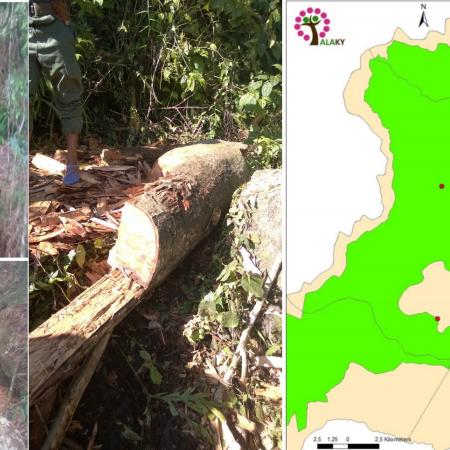
On Tuesday, June 01, 2021, the Talaky project's forest supervisor reported to the Regional Director of the Environment on the existence of pressures in the Beampingaratsy conservation site, Analamary sector. The supervisor said that these pressures are detected by the forest watcher application of the project's co-management forest technician working in this sector. The director immediately called the head of the forest service to discuss strategies and inform the head of forest control. A field raid with the gendarmerie was decided following the meeting. At the aforementioned location, under the supervision of the forest service chief, a visit was made to the fokontany chief to inform him of the purpose of the mission. On the way to observe the infraction, a gentleman was arrested in flagrante delicto with a plank on his shoulder. The forest service chief told him to stop and give us the axe on his hand, leaving the plank on the ground. The chief ordered him to return with us. Five minutes later, we were waiting for some noise or conversation. Everyone did their utmost to surround the place. Four people were arrested in flagrante delicto while making a pirogue in the conservation area. The control manager and his deputy observed the situation and assessed the damage with the eco-guards, who entered all the data via geoODK. On returning to the village, the control manager and his deputy interviewed five people who had been arrested. As for the next step, the head of the forestry department said that the offenders would all be transferred to the public prosecutor's office.

